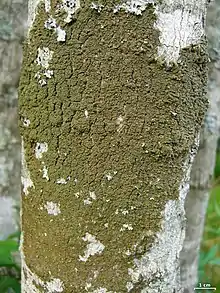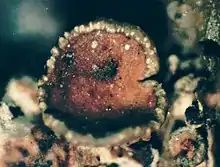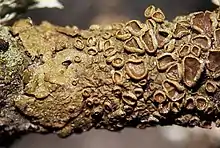| Melanohalea | |
|---|---|
 | |
| Melanohalea halei | |
| Scientific classification | |
| Domain: | Eukaryota |
| Kingdom: | Fungi |
| Division: | Ascomycota |
| Class: | Lecanoromycetes |
| Order: | Lecanorales |
| Family: | Parmeliaceae |
| Genus: | Melanohalea O.Blanco, A.Crespo, Divakar, Essl., D.Hawksw. & Lumbsch (2004) |
| Type species | |
| Melanohalea exasperata (De Not.) O.Blanco, A.Crespo, Divakar, Essl., D.Hawksw. & Lumbsch (2004) | |
Melanohalea is a genus of foliose lichens in the family Parmeliaceae. It contains 30 mostly Northern Hemisphere species that grow on bark or on wood. The genus is characterized by the presence of pseudocyphellae, usually on warts or on the tips of isidia, a non-pored epicortex and a medulla containing depsidones or lacking secondary compounds. Melanohalea was circumscribed in 2004 as a segregate of the morphologically similar genus Melanelia.
Taxonomy
Melanohalea was circumscribed in 2004 by lichenologists Oscar Blanco, Ana Crespo, Pradeep K. Divakar, Theodore Esslinger, David L. Hawksworth and H. Thorsten Lumbsch. It is a segregate of Melanelia, a genus created in 1978 to contain the brown Parmelia species.[1] The circumscription of this genus was questioned later,[2][3] especially after early molecular phylogenetics studies demonstrated that it was not monophyletic.[4][5][6] Subsequently, two genera, Melanelixia and Melanohalea, were created.[4]
Melanohalea originally contained 19 species, including the type, M. exasperata. The species transferred to Melanohalea were formerly included in section Vainioellae of genus Melanelia. This section, in turn, was derived from Parmelia subgenus Euparmelia sect. Vainioellae, originally proposed by Vilmos Gyelnik in 1932. Section Vainioellae included "brown parmelioids" with broad lobes that are round to rather elongate and more or less flat.[1] The "brown parmelioids" refers to Parmelia species lacking atranorin or usnic acid in the cortex, but having a dark to medium-brown thallus colour.[4] Molecular phylogenetic analysis has shown that genus Melanohalea is part of the "Melanohalea" clade, a lineage that includes most of the other "brown parmelioids". Other genera in this clade are Emodomelanelia, Melanelixia, Montanelia, and Pleurosticta.[7]
The genus name combines Melanelia with the name of lichenologist Mason Hale, who, according to the authors, "provided the foundations for subsequent contributions to our knowledge of this family".[4]
Diversification
Methods used to estimate the evolutionary divergence of taxa, including the multispecies coalescent process, suggest that most diversification of Melanohalea occurred throughout the Miocene (23.03 to 5.333 BP) and Pliocene (5.333 million to 2.58 BP), and divergence estimates suggest that diversification that occurred during the glacial cycles of the Pleistocene was not accompanied by speciation in Melanohalea.[8]
Description

Melanohalea lichens have a foliose thallus that is loosely to moderately attached to its substrate. The lobes comprising the thallus are flat to concave with rounded tips, lack cilia, and measure 0.5–7 mm wide. The upper surface of the thallus is olive-green to dark brown, ranging in texture from smooth to wrinkled, and lacks spots or stains. It usually features pseudocyphellae on warts or on the tips of isidia; the presence of soredia and isidia is variable. The upper cortex is paraplectenchymatous (a cell arrangement where the hyphae are oriented in all directions), and measures 10–16 mm thick. The epicortex does not have pores, unlike the related genus Melanelixia. Cell walls contain the α-glucan compound isolichenan. The medulla is white and has a smooth and flat lower surface that is coloured pale brown to black. Rhizines are simple (i.e. unbranched).[4]
The ascomata are apothecial, laminal, sessile to more or less pedicellate. The apothecial disc is brown, and is not perforated. It is initially concave but becomes convex with age. The amphithecium (a layer of cells that surrounds the apothecium) has pseudocyphellate papillae, without spots or stains. Asci are elongated, club-shaped (clavate), Lecanora-type, and thickened at the tip. They lack an internal apical beak, and have between 8 and 32 spores. Ascospores of Melanohalea are spherical to ovoid or ellipsoid in shape, thin-walled, colourless, and measure 5.5–20 by 4–12.5 μm. The conidiomata are pycnidial, immersed, and laminal. The shape of the conidia ranges from cylindrical to fusiform (spindle-shaped); they are simple (i.e., lacking partitions called septa), colourless, and measure 5–8.5 by 1 μm long.[4]
Chemistry
The cortex of Melanohalea lichens have a brown pigment, but lack other compounds. The medulla contains depsidones (including fumarprotocetraric acid and norstictic acid) or lack secondary metabolites.[4] M. nilgirica contains the aliphatic compound caperatic acid, which is rare in the brown parmelioid lichens, known only to exist in Melanelia stygia, the type species of Melanelia.[9]
Habitat and distribution
.JPG.webp)
Most Melanohalea occur primarily on bark and wood throughout the Holarctic; only four species occur in the Southern Hemisphere.[8] Melanohalea peruviana is the only species in the genus that has been reported from tropical South America, although it is poorly known – a single collection from an altitude of 4,400 feet (1,300 m) in the Peruvian Andes.[10] The only other Melanohalea species found in a tropical habitat is M. mexicana, a highland species from south central Mexico.[11] Eight members of the genus are found in China;[12] seven occur in the Nordic lichen flora.[13] The five Melanohalea species found in Greenland may play a role in monitoring the impact of climate change, as arctic-alpine lichens are sensitive to fluctuations in the temperature of winter climates, and winter icing events affect lichen-dominated ecosystems.[14] Similarly, a study of the effect of air pollution surrounding the Mongolian capital Ulan Bator showed widespread damage to a variety of lichens (where the thallus was bleached, deformed, or reduced in size), including Melanohalea septentrionalis.[15]
Most Melanohalea species have a broad geographic distribution, although there are a few that have more restricted ranges. Otte and colleagues suggested in a 2005 study that distribution patterns in Melanohalea are largely determined by contemporary ecogeographical factors, and most species have reached their biogeographical limits in the Northern Hemisphere.[16] The distributions of M. elegantula and M. exasperatula seem to be affected by anthropogenic factors, including eutrophication and air pollution.[8] Melanohalea olivacea and M. septentrionalis, both cold-tolerant circumpolar species, have the south-west limit of their distribution range in Switzerland. They are considered relicts of the last ice age and are vulnerable global climate warming in that country.[17]
Ecology
Several species of lichenicolous fungi have been recorded growing on Melanohalea species. These include Epithamnolia xanthoriae, Xenonectriella septemseptata, Plectocarpon melanohaleae (on M. ushuaiensis), Abrothallus bertianus, Zwackhiomyces melanohaleae (on M. exasperata), Phoma melanohaleicola (on M. exasperata), Didymocyrtis consimilis, Stigmidium exasperatum (on M. exasperata), Sphaeropezia melaneliae (on M. olivacea), Arthrorhaphis olivaceae (on M. olivacea), Epithamnolia xanthoriae, Xenonectriella septemseptata, Plectocarpon melanohaleae (on M. ushuaiensis),[18] Crittendenia coppinsii (on M. exasperatula),[19] and Stagonospora exasperatulae (on M. exasperatula).[20]
Conservation
Melanohalea septentrionalis is listed as endangered in the Red List of Switzerland.[21] Although M. olivacea was left off this list over uncertainties about its taxonomic status, it has been preliminarily assessed as critically endangered in Switzerland using the IUCN Red List criteria. It has received the same assessment in the neighbouring countries Germany and France.[17] Melanohalea halei is the only species in this genus that has been assessed for the global IUCN Red List. Because of its broad geographic distribution, breadth of ecological niches, and large, stable population size, it has been assessed as a least-concern species.[22]
Species
Melanohalea originally included 19 species transferred from Melanelia. In the following years, new species in the genus were described from India, Tibet, Mexico, and Peru. In 2016, Leavitt and colleagues used genetic analyses to help identify 6 previously undescribed morphologically cryptic species in Melanohalea.[23] As of August 2022, Species Fungorum accepts 30 species of Melanohalea.[24]
- Melanohalea austroamericana Essl., Divakar, A.Crespo, S.D.Leav. & Lumbsch (2016)[23]
- Melanohalea beringiana S.D.Leav., Essl., Divakar, A.Crespo & Lumbsch (2016)[23]
- Melanohalea clairi S.D.Leav., Essl., Divakar, A.Crespo & Lumbsch (2016)[23]
- Melanohalea columbiana S.D.Leav., Essl., Divakar, A.Crespo & Lumbsch (2016)[23]
- Melanohalea davidii S.D.Leav., Essl., Divakar, A.Crespo & Lumbsch (2016)[23]
- Melanohalea elegantula (Zahlbr.) O.Blanco, A.Crespo, Divakar, Essl., D.Hawksw. & Lumbsch (2004)
- Melanohalea exasperata (De Not.) O.Blanco, A.Crespo, Divakar, Essl., D.Hawksw. & Lumbsch (2004)
_O._Blanco_et_al_233238.jpg.webp)

- Melanohalea exasperatula (Nyl.) O.Blanco, A.Crespo, Divakar, Essl., D.Hawksw. & Lumbsch (2004)
- Melanohalea gomukhensis (Divakar, Upreti & Elix) O.Blanco, A.Crespo, Divakar, Essl., D.Hawksw. & Lumbsch (2004)
- Melanohalea halei (Ahti) O.Blanco, A.Crespo, Divakar, Essl., D.Hawksw. & Lumbsch (2004)
- Melanohalea inactiva (P.M.Jørg.) O.Blanco, A.Crespo, Divakar, Essl., D.Hawksw. & Lumbsch (2004)
- Melanohalea infumata (Nyl.) O.Blanco, A.Crespo, Divakar, Essl., D.Hawksw. & Lumbsch (2004)
- Melanohalea laciniatula (Flagey ex H.Olivier) O.Blanco, A.Crespo, Divakar, Essl., D.Hawksw. & Lumbsch (2004)
- Melanohalea lobulata F.G.Meng & H.Y.Wang (2009)[25] – Tibet
- Melanohalea mexicana Essl. & R.-E.Pérez (2010)[11] – Mexico
- Melanohalea multispora (A.Schneid.) O.Blanco, A.Crespo, Divakar, Essl., D.Hawksw. & Lumbsch (2004)
- Melanohalea nilgirica Divakar & Upreti (2005)[9] – India
- Melanohalea olivacea (L.) O.Blanco, A.Crespo, Divakar, Essl., D.Hawksw. & Lumbsch (2004)
- Melanohalea olivaceoides (Krog) O.Blanco, A.Crespo, Divakar, Essl., D.Hawksw. & Lumbsch (2004)
- Melanohalea peruviana Essl. (2012)[10] – Peru
- Melanohalea poeltii (Essl.) O.Blanco, A.Crespo, Divakar, Essl., D.Hawksw. & Lumbsch (2004) – Nepal; India[9]
- Melanohalea septentrionalis (Lynge) O.Blanco, A.Crespo, Divakar, Essl., D.Hawksw. & Lumbsch (2004) – North America; Europe; Asia[12]
- Melanohalea subelegantula (Essl.) O.Blanco, A.Crespo, Divakar, Essl., D.Hawksw. & Lumbsch (2004) – western North America; Tibet[12]
- Melanohalea subexasperata F.G.Meng & H.Y.Wang (2010)[26] – Tibet
- Melanohalea subolivacea (Nyl. ex Hasse) O.Blanco, A.Crespo, Divakar, Essl., D.Hawksw. & Lumbsch (2004)
- Melanohalea subverruculifera (J.C.Wei & Y.M.Jiang) O.Blanco, A.Crespo, Divakar, Essl., D.Hawksw. & Lumbsch (2004)
- Melanohalea tahltan S.D.Leav., Essl., Divakar, A.Crespo & Lumbsch (2016)[23]
- Melanohalea trabeculata (Ahti) O.Blanco, A.Crespo, Divakar, Essl., D.Hawksw. & Lumbsch (2004)
- Melanohalea ushuaiensis (Zahlbr.) O.Blanco, A.Crespo, Divakar, Essl., D.Hawksw. & Lumbsch (2004)
- Melanohalea zopheroa (Essl.) O.Blanco, A.Crespo, Divakar, Essl., D.Hawksw. & Lumbsch (2004)
References
- 1 2 Esslinger, Theodore L. (1978). "A new status for the brown Parmeliae". Mycotaxon. 7 (1): 45–54.
- ↑ Lumbsch, H. Thorsten; Kothe, Hans; John A., Elix (1988). "Resurrection of the lichen genus Pleurosticta Petrak (Parmeliaceae: Ascomycotina)". Mycotaxon. 33: 447–455.
- ↑ Thell, A. (1995). "A new position of the Cetraria commixta group in Melanelia (Ascomycotina, Parmeliaceae)". Nova Hedwigia. 60 (3–4): 407–422.
- 1 2 3 4 5 6 7 Blanco, Oscar; Crespo, Ana; Divakar, Pradeep K.; Esslinger, Theodore L.; Hawksworth, David L.; Lumbsch, H. Thorsten (2004). "Melanelixia and Melanohalea, two new genera segregated from Melanelia (Parmeliaceae) based on molecular and morphological data". Mycological Research. 108 (8): 873–884. doi:10.1017/S0953756204000723. PMID 15449592.
- ↑ Thell, Arne; Feuerer, Tassilo; Kärnefelt, Ingvar; Myllys, Leena; Stenroos, Soili (2004). "Monophyletic groups within the Parmeliaceae identified by ITS rDNA, β-tubulin and GAPDH sequences". Mycological Progress. 3 (4): 297–314. doi:10.1007/s11557-006-0100-1. S2CID 39393303.
- ↑ Blanco, Oscar; Crespo, Ana; Ree, Richard H.; Lumbsch, H. Thorsten (2006). "Major clades of parmelioid lichens (Parmeliaceae, Ascomycota) and the evolution of their morphological and chemical diversity". Molecular Phylogenetics and Evolution. 39 (1): 52–69. doi:10.1016/j.ympev.2005.12.015. PMID 16481204.
- ↑ Crespo, Ana; Kauff, Frank; Divakar, Pradeep K.; del Prado, Ruth; Pérez-Ortega, Sergio; de Paz, Guillermo Amo; et al. (2010). "Phylogenetic generic classification of parmelioid lichens (Parmeliaceae, Ascomycota) based on molecular, morphological and chemical evidence". Taxon. 59 (6): 1735–1753. doi:10.1002/tax.596008.
- 1 2 3 Leavitt, Steven D.; Esslinger, Theodore L.; Divakar, Pradeep K.; Lumbsch, H. (2012). "Miocene and Pliocene dominated diversification of the lichen-forming fungal genus Melanohalea (Parmeliaceae, Ascomycota) and Pleistocene population expansions". BMC Evolutionary Biology. 12 (1): 176. doi:10.1186/1471-2148-12-176. PMC 3499221. PMID 22963132.
- 1 2 3 Divakar, Pradeep K.; Upreti, Dalip K. (2005). "A new species in Melanohalea (Parmeliaceae, Ascomycotina) and new lichen records from India". The Lichenologist. 37 (6): 511–517. doi:10.1017/S0024282905015215. S2CID 85751570.
- 1 2 Esslinger, Theodore L. (2012). "A new species of Melanohalea from the Andes Mountains in central Peru" (PDF). Opuscula Philolichenum. 11: 322–324.
- 1 2 Esslinger, Theodore L.; Pérez Pérez, Rosa Emilia (2010). "The lichen genus Melanohalea in Mexico, including a new endemic species". Bibliotheca Lichenologica. 105: 239–245.
- 1 2 3 Wang, Hai-Ying; Chen, Jian-Bin; Wei, Jiang-Chun (2009). "A phylogenetic analysis of Melanelia tominii and four new records of brown parmelioid lichens from China". Mycotaxon. 107: 163–173. doi:10.5248/107.163.
- ↑ Westberg, W.; Thell, A. (2011). "Melanohalea". In Thell, Arne; Moberg, Roland (eds.). Nordic Lichen Flora. Vol. 4. Svenska Botaniska Föreningen. pp. 76–81. ISBN 978-91-85221-24-0.
- ↑ Leavitt, Steven D.; Esslinger, Theodore L.; Hansen, Eric Steen; Divakar, Pradeep K.; Crespo, Ana; Loomis, Bradley F.; Lumbsch, H. Thorsten (2013). "DNA barcoding of brown Parmeliae (Parmeliaceae) species: a molecular approach for accurate specimen identification, emphasizing species in Greenland". Organisms Diversity & Evolution. 14 (1): 11–20. doi:10.1007/s13127-013-0147-1. S2CID 17173833.
- ↑ Hauck, Markus (2008). "Epiphytic lichens indicate recent increase in air pollution in the Mongolian capital Ulan Bator". The Lichenologist. 40 (2): 165–168. doi:10.1017/S0024282908007561. S2CID 86305444.
- ↑ Otte, Volker; Esslinger, Theodore L.; Litterski, Birgit (2005). "Global distribution of the European species of the lichen genus Melanelia Essl". Journal of Biogeography. 32 (7): 1221–1241. doi:10.1111/j.1365-2699.2005.01268.x. S2CID 85994087.
- 1 2 Truong, Camille; Naciri, Yamama; Clerc, Philippe (2009). "Multivariate analysis of anatomical characters confirms the differentiation of two morphologically close species, Melanohalea olivacea (L.) O. Blanco et al. and M. septentrionalis (Lynge) O. Blanco et al" (PDF). The Lichenologist. 41 (6): 649–661. doi:10.1017/S0024282909990260. S2CID 86681283.
- ↑ Diederich, Paul; Lawrey, James D.; Ertz, Damien (2018). "The 2018 classification and checklist of lichenicolous fungi, with 2000 non-lichenized, obligately lichenicolous taxa". The Bryologist. 121 (3): 340–425. doi:10.1639/0007-2745-121.3.340. S2CID 92396850.
- ↑ Millanes, Ana M.; Diederich, Paul; Westberg, Martin; Wedin, Mats (2021). "Crittendenia gen. nov., a new lichenicolous lineage in the Agaricostilbomycetes (Pucciniomycotina), and a review of the biology, phylogeny and classification of lichenicolous heterobasidiomycetes". The Lichenologist. 53: 103–116. doi:10.1017/S002428292000033X.
- ↑ Darmostuk, Valeriy V.; Sira, Olha Ye. (2020). "New and remarkable records of lichenicolous fungi from Ternopil Oblast (Ukraine)" (PDF). Czech Mycology. 72 (1): 33–41. doi:10.33585/cmy.72103. S2CID 219165318.
- ↑ Scheidegger, C.; Clerc, P. (2002). Liste rouge des espèces menacées en Suisse: lichens épiphytes et terricoles (Report) (in French). Bern, Birmensdorf et Genève: Office fédéral de l'environnement.
- ↑ Allen, J.; Yahr, R.; Lymbery, C.; Batallas-Molina, R.; Dal Forno, M.; Howe, N.; Lendemer, J.; McMullin, T.; Mertens, A.; Paquette, H.; Petix, M.; Reese Næsborg, R.; Roberts, F.; Sharrett, S.; Villella, J. (10 May 2021). "Melanohalea halei". IUCN Red List of Threatened Species. 10 May 2021. Retrieved 5 September 2021.
- 1 2 3 4 5 6 7 Leavitt, Steven D.; Esslinger, Theodore L.; Divakar, Pradeep K.; Crespo, Ana; Lumbsch, H. Thorsten (2016). "Hidden diversity before our eyes: Delimiting and describing cryptic lichen-forming fungal species in camouflage lichens (Parmeliaceae, Ascomycota)". Fungal Biology. 120 (11): 1374–1391. doi:10.1016/j.funbio.2016.06.001. PMID 27742095.
- ↑ Kirk, P.M. (ed.). "Search results for Melanohalea". Species 2000 & ITIS Catalogue of Life, 2020-04-16 Beta. Archived from the original on 2020-06-08. Retrieved June 7, 2020.
- ↑ Zhao, Zun-Tian; Meng, Fan-Ge; Li, Hong-Mei; Wang, Hai-Ying (2009). "A new species of Melanohalea (Parmeliaceae) from the Tibetan Plateau". Mycotaxon. 108 (1): 347–352. doi:10.5248/108.347.
- ↑ Sun, Li-Yan; Meng, Fan-Ge; Li, Hong-Mei; Wang, Hai-Ying; Zhao, Zun-Tian (2010). "A new lichen, Melanohalea subexasperata (Parmeliaceae), from the Tibetan Plateau". Mycotaxon. 111 (1): 65–69. doi:10.5248/111.65.